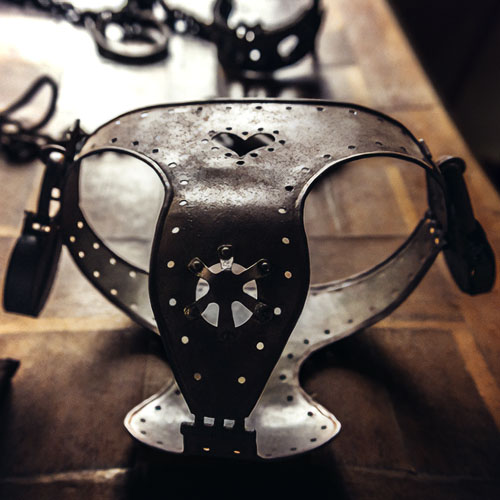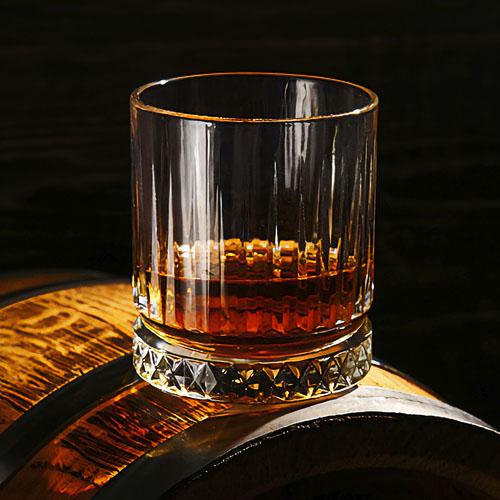It’s easy to make, easy to score, cheap, and the high lasts ten times longer than crack cocaine. Little wonder that methamphetamine has become the nation’s fastest-growing illegal drug. It has also thrust horrific violence into the heartland of America.
Monsters, Mobsters and the War on Meth
Agents Ruben Cortes and Mike Sanchez have a bad feeling about the Jeep Cherokee parked across the street. This was supposed to be a face-to-face with the two men in the Chevy Suburban to close the deal on a 30-pound load of ephedrine, the chemical precursor to methamphetamine. The agents have a tagged canister of the stuff in their camper-shell pickup, and the plan was to sell it to the guys in the Suburban for $30,000, track the chemical to the lab site, and then bust the whole operation. But who are the two guys in the Cherokee?
The hand-over of cash for chemicals is always the most dangerous moment in an undercover operation. Often the bad guys will pay for the goods, then accomplices or rivals will stick up the agents for the cash, sometimes violently. So for Sanchez and Cortes the presence of the Cherokee raises a red flag. Worse, the guys in the Suburban seem a little too eager to make the transaction, raising another red flag — which is one too many. Alarmed, the agents tell the men in the Suburban the deal’s off and head back to their pickup to leave.
Sanchez slides behind the wheel while Cortes gets on his cell phone to inform their supervisor that the deal smells like a rip and they’re calling it off. But before he can finish his sentence, Sanchez yells, “Fuck!” and floors the accelerator, slamming Cortes against the seat back. Fuck is right. The Suburban is on their tail, and the Cherokee has pulled a U-turn and is coming after them too.
“Put someone behind us,” Cortes yells into the cell phone. “We need a vehicle between us and the Suburban.”
There are seven backup vehicles on the ground and a police helicopter overhead. Closest to the chase is agent Mark Gomez, who wheels his unmarked Thunderbird out from cover and after the Suburban. He plans to pass and block it so that Cortes and Sanchez can get away. When the Suburban driver blocks him on the left, Gomez tries to pass on the right. They’re doing 50 m.p.h. on a city street filled with traffic when Gomez pulls alongside the Suburban. Suddenly the Suburban slows down and both its tinted passenger-side windows go down. In two heartbeats, Gomez realizes what’s happening and dives for the floor. The front-seat passenger is shooting at him with a nine-milimeter automatic. It’s point-blank range. Chunks of steel-jacketed lead shatter the Thunderbird’s cruise control and take out the air bag.
The bullets keep flying, one smashing into the window of a fast-food restaurant, as people on the sidewalk look on in horrified fascination. The four cars continue the wild chase for about a mile, running three red lights, until the backup pursuit cars converge on the Suburban amid screaming sirens, searchlight beams, and commands from bullhorns. There are cocked guns and trigger fingers at the ready, but the men in the Suburban have done enough shooting and give up without a fight. At the same time, the guys in the Cherokee ditch their vehicle and bolt, but they’re quickly caught and cuffed, and it’s over.
Another shootout on the mean streets of Tijuana or Guadalajara? Think again. This happened on a Tuesday night last year in downtown San Bernardino, California, where a war that most Americans don’t even know about is being fought daily. The enemy is the central-nervous-system stimulant d-methamphetamine hydrochloride, a.k.a. crystal meth. So much is produced illegally in California — an estimated 50 tons annually — that the state has been labeled a “source nation” by the Drug Enforcement Administration. Of the roughly 2,000 meth-lab busts in California in 1997, 567 went down in San Bernardino County, making it the busiest meth-producing county in the state.
Gomez, Cortes, and Sanchez are not their real names, but they are real agents in the 17- man San Bernardino County Sheriff’s Department’s Meth Interdiction Squad, which targets the operations of the Mexican-national crime families who took over the California meth trade from outlaw biker gangs in the late 1980’s and turned it into a billion-dollar business. “The Mexican-national labs here ship dope all across the whole U.S.,” says squad commander Lieutenant Ross Dvorak. “Ninety percent of the meth produced in California comes from the Mexican-national labs, and those are the ones we go after.”
There’s always a choice to be made when busting a meth lab: bulletproof vest and gun drawn, or full protective gear. “You can’t be right both ways,” says squad commander Lieutenant Ross Dvorak.
The Suburban-Cherokee mission was unusual in that it blew up on the street without taking down the intended target. “Our guys usually bust the labs,” says Dvorak. “We target the guys in charge and follow the chemicals. When we raid a lab, we go in full raid gear.”
That means body armor and automatic weapons, with the fire department on standby and two officers in full protective gear with self-contained breathing apparatus. (Two so that if the first one succumbs to toxic fumes, the second can go in and drag his partner out.) Dvorak says there is always a choice to make on a lab raid. “Do you go in with your bulletproof vest and your gun drawn, or do you go in suited in full protective gear?” he asks. “You can’t be right both ways. And if you shoot your gun, you could cause an explosion.”
The lawmen have good reason to be cautious. According to the California Department of Justice, fire or explosion occurs periodically at one of six clandestine meth-lab sites in California, and guns are almost always present. The explosions often blast buildings off their foundations, and the guns are usually heavy caliber. “Very rarely do we go to a location where they don’t have weapons,” Dvorak says, “and the ones they have are often military assault-type rifles.”
Indeed, violence has become a hallmark of the meth business as it has evolved from the stove tops of biker gangs to the sophisticated labs and distribution networks of the Mexican-national crime families. With grim frequency, the mutilated corpses of suspected informants turn up in car trunks on the streets of Southern California. But the violence of the Mexican meth mob pales next to the savagery of the users, or “tweakers,” who buy their product. Meth can turn ordinary people into monsters. Consider, for example, Veronica and Ivan Gonzales, of Chula Vista, California, who murdered their four-year-old niece, Genny Rojas, in front of six other children. Heavy meth users, Ivan and Veronica subjected Genny to a slow, horrible death in unimaginable squalor that sickened even hardened investigators. “It was so bad in that house that people had to work in shifts so they wouldn’t vomit,” says Daniel Goldstein, the San Diego County deputy district attorney who won a death-penalty conviction against the Gonzales’s in the summer of 1998.
What won Goldstein the death penalty was evidence of systematic, sadistic torture inflicted on Genny in the weeks before her death. “They hung her in a closet,” he recalls. “They stuffed her in a box. They used a blow-dryer on her face and a curling iron on her body. There wasn’t an inch of her body not laced with injury. There wasn’t a hair left on her head from third-degree burns from being immersed in 150-degree water. She was missing all the skin on her ears from this hood they put on her head. Her lip was severed from her gum. There were ligature lines on her ankles. They had handcuffed her biceps when they hung her in the closet with her arms tied behind her back.” All because the unfortunate little girl happened to spill some of Ivan Gonzales’s dope.
Goldstein, whose San Diego County prosecutorial district has the highest known meth-abuse rate in the world, believes the Gonzales’s exemplify the drug’s horrifying effects. “For people with a propensity for violence, meth is like pouring gasoline on a fire,” he says. “There’s something about this drug that magnifies any personality defect they already possess, that silences any little voice inside that would have said, ‘Hey, this is wrong.’”
What exactly is this drug that makes terrible wrongs seem right? D-methamphetamine hydrochloride is a crystalline alkaloid derived from ephedrine, which comes from the Chinese ephedra plant. Ephedrine is converted to methamphetamine through a chemical-reaction process that involves cooking it with red phosphorus and hydriodic acid, cooling the bubbling liquid, adding caustic soda to neutralize the acid, then treating it with Freon or ethyl ether to extract the methamphetamine. After that, if the process has not killed the “chef” with a release of one of the poison-gas byproducts, if it has not exploded or burst into spontaneous flame (phosphorus can ignite spontaneously, or it can proceed chemically into the stage of white phosphorus, which produces phosphine gas, one of the deadliest known toxins), the methamphetamine is dried into crystals.
Crystal meth can be snorted, smoked, or injected, and once it reaches the brain things happen fast. The d-methamphetamine hydrochloride triggers a massive release of the neurotransmitter dopamine, which activates the brain’s reward center and stimulates production of the fight-or-flight hormone epinephrine. Normally, dopamine release is short-term, with the dopamine molecules reabsorbed after they have done their work. But methamphetamine blocks reabsorption while continuing to trigger dopamine, effectively hot-wiring the limbic system by bypassing the neural controls and jamming the pleasure center open. It also jams open the switch that produces epinephrine, more commonly known as adrenaline.
The jammed adrenaline switch is what causes the trouble. “What starts out as an all-encompassing reward of pleasure turns to paranoia,” says Dr. Alexander Stalcup, a Concord, California, psychotherapist who specializes in the treatment of meth abusers. “Then it turns to irritation and, finally, rage.”
The neural system is designed for an adrenaline circulation measured in minutes, but heavy meth use can keep adrenaline at crisis level for hours or even days. Overstimulated, super-sensitive, and paranoid, tweakers inhabit a bizarre, threatening landscape. They hear things that aren’t being said, see things that aren’t there. A common psychic by-product of meth use is the manifestation of evil in demonic form. Tweakers will nail windows shut and cover them with black curtains to keep out the devil, vampires, or warlocks. They guard against their evil visions with pentagrams and black magic. They sometimes also try to kill the demons, with tragic consequences.
Eric Starr Smith had been bingeing on crystal meth for two days before he left his sister’s Phoenix-area home with his 13- and 14-year-old sons to take them fishing in New Mexico. At a rest stop east of Albuquerque, he began stabbing his oldest son, Eric junior, in the neck with a hunting knife. A trucker tried to stop him, but Smith drove away, hacking at his son’s head until he severed it. Then he tossed it out the window and kept driving east on Interstate 40. When caught by the police, Smith said the devil had been in the van with him. In June 1997 he was convicted of first-degree murder and sentenced to life in prison.
Despite its deadly toll and undeniable dangers, methamphetamine use continues to soar across the country. Nationally, meth arrests by the D.E.A., which goes after the serious players, have almost tripled in four years, rising from 2,857 in 1995 to 7,608 in 1998. In California, hospital emergency episodes relating to methamphetamine tripled between 1990 and 1997. In Washington state, the number of people seeking treatment for meth abuse has increased 600 percent since 1992. In Phoenix, meth violence had claimed so many lives by 1995 that then Arizona Governor Fife Symington named an Air National Guard lieutenant colonel state “meth czar.” In January 1998 Wyoming Governor Jim Geringer announced a state battle plan in the face of a 280-percent increase in meth arrests between 1993 and 1997. In Kansas City, Missouri, Major Craig Knouse, commander of the Kansas City Police Department’s drug-enforcement unit, reports that the city is awash in methamphetamine from California, and U.S. Attorney Steven Hill, Jr., reports that 80 percent of the narcotics cases tried in Missouri are now methamphetamine-related. In Iowa, meth arrests are up 400 percent over the past three years, and the director of the Division of Narcotics Enforcement, Ken Carter, says the state is in the middle of a meth epidemic.
It is an epidemic that has been brewing for decades. Amphetamine was first marketed in the U.S. in the early 1930’s as the respiratory aid Benzedrine. During World War II, Benzedrine was issued as a stimulant to combat troops and fighter pilots, despite its negative side effects. In the fifties and sixties housewives gobbled Dexedrine, a commercial form of amphetamine, to slim down, while college students used Dexies to cram for exams and truckers popped “bennies” to stay awake. By the mid-sixties amphetamine had evolved into the more potent methamphetamine, which enterprising outlaw bikers cooked and sold as “crank.” Crank acquired a nasty reputation for provoking violence, but its popularity spread, especially among the “white trash” working class and heavy-metal rock enthusiasts.
In the 1980’s, Mexican drug entrepreneurs from the state of Michoacán, where U.S.-supported eradication programs had crippled the marijuana industry, moved their business efforts north, taking control of meth production in California. At the same time, a new refining process, perfected in the late 1980’s, enabled these crime families to manufacture and distribute the far more potent form known as d-methamphetamine, which would prove enormously profitable.
“Smith drove away, hacking at his son’s head until he severed it. Then he tossed it out the window and kept driving east.”
The new, improved meth was a drug whose time had come. Marijuana’s gentle buzz complemented the peace-and-love vibe of the sixties. Cocaine fueled the libertine, disco-crazed decadence of the seventies and the high-flying conspicuous consumption of the eighties, then devolved for the most part into a ghetto staple in the form of crack. Now there was a stimulant that was easy to make, easy to score, and, at less than $80 a gram on average, cheaper than cocaine. What’s more, its high lasted ten times longer than crack’s, without the inner-city stigma and risks.
“Meth is crossing demographic lines that crack cocaine didn’t,” says Mike Van Winkle, a spokesperson for the California Department of Justice. “To buy meth, you don’t have to put your life on the line the way you would to buy crack.” Consequently, Van Winkle says, the user base has broadened exponentially. “It’s a wider spread than it looks like. On the six-o’clock news the people getting busted for meth look like white trash. But in reality, the people who can afford the high-level treatment programs are way up the demographic scale from that.”
Indeed, most tweakers have probably never set foot in a trailer camp, much less the ghetto. A 1997 study by the California Alcohol and Drug Data System showed that 76 percent of the approximately 22,000 persons seeking treatment for meth abuse in 1996 were white, most between the ages of 25 and 35. In other states where meth use is spreading, the ages of whites seeking treatment are even lower.
Olivia Scaglia, who counsels teens and preteens at the Area Substance Abuse Council in Cedar Rapids, Iowa, says that meth had become the drug of choice among the young people she counseled in 1997. “These kids choose meth,” Scaglia explains, “because it is so much cheaper than cocaine. Besides, cocaine is a drug their parents did, which means cocaine is not trendy.”
Meth is not only cheap, potent, and in. It also offers young tweakers a community of the like-minded that validates their obsession. A cursory search of the Internet using keywords like “crystal” and “meth” turns up chat boards filled with messages from teens seeking meth recipes, debating meth’s virtues, and swapping tweaking tales. High schoolers desperate for hookups to meth dealers offer sex in exchange for dope, while others promise big money to anyone who will front them meth to sell in their hometown.
White House drug czar Barry McCaffrey finds this rise in teen meth use especially alarming and, like Scaglia, believes it can be attributed in large measure to a reaction against cocaine. “A lot of young folks have seen the impact of crack and don’t want any part of it,” he says. McCattrey adds that unfortunately “they don’t have the same sensitivity to drugs like amphetamine. And that’s too bad, because methamphetamine is the worst drug of all.”
For beleaguered law-enforcement officials, battling the tide of California meth is an almost Sisyphean task. In just the past half decade, a highly efficient pipeline from California has emerged, crisscrossing the country by bus, commercial airliner, U.S. mail, FedEx, truck, car, and train, pouring the drug into the American heartland.
In response, President Clinton has officially declared the war on meth a national priority, and a corridor through Iowa, Kansas, Missouri, South Dakota, and Nebraska has been designated a high-impact drug-trafficking area that qualifies for special federal funding. In addition, Washington has earmarked $34 million of the $516-million national Community Oriented Policing Services (COPS) fund specifically for local anti-meth efforts in 1998-99. This is a drop in the bucket compared to the oceans of dollars at the disposal of the meth lords.
Remember that 30-pound load of ephedrine at the center of the shootout in San Bernardino? Gregg McClung, supervisor of the California Bureau of Narcotics Enforcement’s Clandestine Lab Task Force in Southern California, runs down the math of meth dealing as follows: In a typical Mexican-national lab, a 30-pound load of ephedrine would yield 24 pounds of methamphetamine worth $6,000 a pound — a total of $144,000 wholesale on the West Coast. The price rises to $12,000 a pound in Kansas City, which comes to $288,000 if the 24 pounds were shipped uncut. But meth usually gets cut two-for-one at the lab, pushing the Missouri wholesale value for the dope cooked from that one batch in California to $576,000. In 1997 the B.N.E. reported seizures of 16,800 pounds of meth, which, at the Midwest wholesale value, figuring in the cut, adds up to $403 million. Seizures are commonly acknowledged to reflect no more than one sixth of the dope produced, putting the Missouri value of the estimated annual California meth output at $2.4 billion!
“California has become the methamphetamine pharmacy to the nation,” says Robert Bender, former chief of D. E. A. operations in Los Angeles. (Bender now works for a private security firm.) “What Colombia is to the cocaine business, Southern California has become to the rest of this country.”
With its estimated clandestine methlab production of 50 tons, worth billions on the streets, the Golden State qualifies as a world power on the international drug scene. (By comparison, cocaine production in Colombia is estimated at 150 tons.) It’s a situation so grave that more than half of the aforementioned COPS anti-meth budget — $18.2 million out of a total of $34 million — has been allocated to the B.N.E. to fight the meth war in California. In addition, B.N.E. chief Joe Doane reports that in 1999 the bureau has doubled its manpower devoted to policing meth in the state. “Out of 350 street agents detailed to narcotics enforcement, we now have 150 devoted solely to meth,” he says. “That means the other four drugs — heroin, cocaine, crack cocaine, and hallucinogens — and everything else are divided between the other 200 agents.”
Those fighting the war acknowledge that they are up against an increasingly sophisticated enemy. Of the more than 2,000 meth labs busted in California in 1997, the vast majority were “Beavis and Butt-head” joints, low-volume stove-top setups that produce only a fraction of the meth consumed. “When we were setting up our special meth-interdiction squad four years ago,” says Dvorak, “we found that 90 percent of the meth was coming from ten percent of the labs, those run by Mexican-national operations. It’s those ten percent we go after.”
The Mexican-national labs are multilayered operations, says Dvorak. “You have people procuring real estate for the cook sites, chemical brokers in charge of procuring the chemicals, runners who bring the chemicals from the warehouse to the cook site, people in charge of the glassware for the cooking, still other people involved in the distribution.”
Fighting that level of sophistication requires determination and constant intelligence-gathering. Mike Digby, a nine-year veteran of the B.N.E .’s Clandestine Lab Task Force in Southern California, collects intelligence like a twentieth-century version of the Indian tracker of the Old West, scouting an urban terrain of cheap motels, parking lots, auto-body shops, and strip malls, where he seeks clues to meth-trafficking operations that most people would not notice. He also reviews conversations wiretapped by the D.E.A., looking for mention of known or suspected traffickers and cook sites. Finally, and crucially, he cultivates snitches inside the meth organizations. “We don’t use informants to bust street-level dealers or users,” he says. “We’re after real live traffickers willing to turn the competition.”
Or an insider willing to pass information on his own organization, at the risk of his life. In early 1993 Digby enlisted an informant involved in a massive meth cooking-and-distribution operation run by a Mexican-national family from their base in a Los Angeles suburb. They ran a major lab located on an isolated farm property up the coast.
Eighteen months after recruiting the snitch, Digby had a three-man undercover video crew hidden at the lab site to tape an entire cooking operation, the first time a Mexican-national cooking enterprise had been compromised so deeply. A field force of 82 agents secured the perimeter of the property for the duration of the lab cook, which lasted 72 hours, and once the call came that enough meth had been cooked, a raiding force swept in and arrested the 18 men at the site, confiscating 110 pounds of meth. There was enough videotaped 18-month evidence to put 30 people in jail.
Part of Digby’s craft is protecting his informants from suspicion. His snitch in the long undercover operation survived. Others have been less fortunate.
Omar Gutierrez, a Mexican national from a meth-dealing family, had turned snitch to beat a bust for precursor trafficking. He lived in South Gate, an L.A. suburb and hub for methamphetamine trafficking, and was privy to the details of major meth-making deals. He knew who was buying what chemical, where it was going to be delivered, and who was going to cook it. Digby was always careful to use the information in ways that couldn’t be traced back to the snitch, but Gutierrez was his own worst enemy. “I think he liked bragging about how well he was connected, how much he knew,” says Digby.
On July 9, 1997, the line between Digby and Gutierrez went dead. The snitch didn’t return Digby’s pages or answer his phone. Four days later, Digby’s worst fear was realized. Gutierrez’s body was found along with the body of another Hispanic man in the trunk of a car in Burbank. Both men had been bound, their throats slashed and teeth smashed — typical of informant executions — and killed by bullets to the back of the head. According to Digby, the man whose body was found with Gutierrez’s was known to have ties to meth traffickers but was not an informant.
Two days later two more bodies were found in the trunk of a parked vehicle in nearby Glendale. The second pair of victims had been killed in the same fashion as the first, and also had ties to Mexican-national meth traffickers. All four had been targets of an apparent effort to plug a leak. Again, only Gutierrez had been an informant. “The others,” Digby says, “just had bad luck.”
“Holeman and his team saw a man dead on the edge of the bed, apparently killed by fumes while trying to stand up.”
There was more bad luck to come.
By mid-1997 a major multi-agency offensive called Operation Meta was under way. The net was tightening around the major players in the meth business. Bodies of suspected informants began to turn up on the streets of L.A. On November 17, 1997, the full thrust of Operation Meta struck with simultaneous predawn raids on three major lab sites within an 80-mile radius of Los Angeles. The drug haul was huge — more than 200 pounds of meth — and 140 people in 11 states were arrested on charges of conspiracy to manufacture, distribute, and sell meth across the country.
Operation Meta was hailed as a major law-enforcement victory. But soon afterward, Digby began hearing that there would be a purge to eliminate informants. He was told it would be carried out not as a surgical action against selected targets, but as a shotgun strike against many in hopes of getting the right ones. Digby didn’t believe it.
Then the body dumps began. “The first was New Year’s Day in Alhambra,” Digby remembers. “Two bodies were found in a parked truck. Then there were two more found in Covina a week later.” Then the bodies of two more execution-style shooting victims were found in the back of a car ditched on the 710 Freeway in Southgate. Though no news accounts hinted at drug-business connections, there were details about the victims in the reports that indicated to Digby that they, too, were meth-family rubouts.
For Digby, the savagery of the snitch purge was standard operating procedure for the Mexican-national meth lords. “These guys have a reputation of doing the kinds of things people write novels about.”
From an airplane cruising at 4,000 feet we can see an odd pattern in the rich farmland of the San Joaquin Valley, 100 miles north of Los Angeles. A double plume of dead vegetation snakes south of a cluster of farm buildings. Something is spreading out and poisoning the groundwater. “That’s caused by waste from a meth-lab cook site,” says Robert Bender. “They were cooking meth and dumping the waste right there. Week after week, hundreds of gallons of toxic waste.”
According to Bender, six pounds of toxic waste are created for every pound of methamphetamine cooked. Using the six-pounds-manufactured-for-everyone-pound-seized formula, the annual California clandestine meth-lab output is 108,000 pounds, which means more than 600,000 pounds of toxic waste containing red phosphorus, hydrochloric acid, hydriodic acid, phosphine, phosgene, and other toxins so caustic they dissolve plumbing are being dumped wherever it is convenient for the criminals. “They dispose of it in agricultural fields, streams, water supplies, and backyards,” says Bender. “They even dump it down drains near schools.”
As it happens, the toxic by-products of meth manufacturing threaten not only the environment but also those who cook the stuff. Fatal explosions and fires at labs occur regularly; fumes from meth cooking destroy lung tissue and induce chemical pneumonia. Phosphine gas, produced in a meth-cooking operation gone wrong, is so deadly that a few molecules in the air will kill instantly. “We don’t believe that the large-scale lab cooks live very long,” says LA-based D.E.A. agent Sharon Carter. “They’re breathing fumes that are so toxic they literally sear tissue. The pay is good for skilled meth cooks, but the life expectancy isn’t.”
Every law-enforcement agency has horror stories of people killed by fumes at meth lab sites, but Tom Holeman, senior narcotics investigator with the L.A. County Sheriff’s Department, may have the grimmest one of all. In August 1996 Holeman, who specializes in clandestine lab busts, received a report regarding bodies on the floor of a motel room in the L.A. suburb of Carson. From the motel manager’s description of the scene, Holeman suspected a methcooking operation; he ordered the site sealed until his squad arrived. He reasoned that whatever had killed the three people in the room was probably still present. Holeman and his team suited up in full biohazard gear before they entered the room.
“We went in under what is known as Level B protection,” says Holeman, “which means full suits and respirators.” Through their face masks, Holeman and his crew saw a woman dead on the floor near the door and a man dead on the edge of the bed, apparently killed by fumes while trying to stand up. Another man was dead in the bathroom, where a meth lab had been set up on a hot plate.
“They broke a cardinal rule of meth cooking,” Holeman says. “They partied and passed out while the stuff was cooking. That’s a big no-no.”
A fatal one in this case. The cookers had set up a flask, a condenser, a hose, and a trap to contain the fumes so there would be no telltale odor. But they had apparently passed out after setting the brew to bubbling, and while they were unconscious the mix had overcooked and exceeded the critical temperature. Overcooking produced the deadly substance white phosphorus. From his examination of the site, Holeman worked it out this way:
“When one man awoke, he went in to check on the brew and he saw something he had never seen before.” The red phosphorus had boiled away, leaving a residue of white phosphorus in a process that generates phosphine gas. The cooker knew something was wrong, but had no idea how wrong. He moved the flask off the hot plate and disconnected the hose from the trap that had collected the fumes. “Phosphine gas,” Holeman says, “is lethal at a concentration of only a few parts per million. It kills instantly.”
It killed the cooker as soon as he disconnected the hose, and the thump of his body against the bathroom door must have awakened his partner in the bedroom. But it was already too late. The phosphine killed the second guy before he could get out of bed. It killed the woman asleep on the floor, and it would have killed anyone who entered the room.
“We ran a gas-chromatographic test for airborne toxin,” says Holeman. “It showed phosphine gas present, hours later, at a much higher level than is required for lethality. That motel manager is lucky he shut the door so fast.
“I wish I could tell that story to the kids who post messages on Websites about the pleasures and excitement of meth cooking,” Holeman says. “I’d like to show them pictures of what these three victims looked like.”
Back in San Bernardino, Dvorak’s Meth Interdiction Squad expects no letup in the pace of lab raids. “We busted a big lab in the high desert at Ora Grande three weeks ago,” says squad member Sergeant Mike Bayer. “When we raided the site, there were six 22-liter [six-gallon] flasks cooking, and there were 12 more flasks in place. Six of them had just finished cooking, and the other six were ready to go.”
A six-flask cook is capable of producing 100 pounds of meth every 12 hours, and this lab was apparently operating round the clock. That makes it the biggest meth-lab operation ever discovered in California, but it received almost no mention in the press. It was just another lab bust in another day of the meth war in San Bernardino County.
Nevertheless, Bayer and Dvorak are encouraged. “We’ve put some families out of business,” Bayer says. “And we’re making it harder for the others. If we could shut off the supply of ephedrine, or pseudo-ephedrine, we could have it it licked.”

























